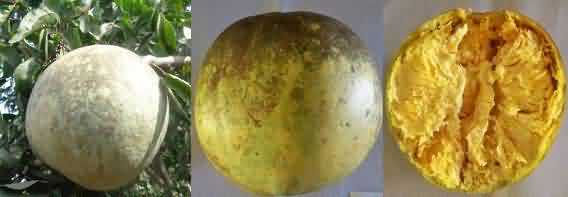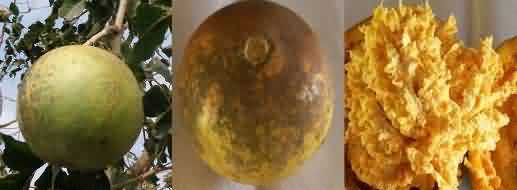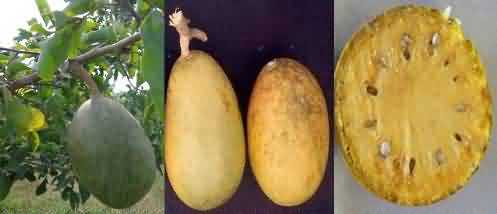बेल की खेती और बेल के बाग का स्वास्थ्य प्रबंधन
 Bael (Aegle marmelos (L) Correa.), a native fruit of religious importance is well known to the Indian people for its nutritional and medicinal values.
Bael (Aegle marmelos (L) Correa.), a native fruit of religious importance is well known to the Indian people for its nutritional and medicinal values.
Leaves are used as sacred offering to ‘Lord Shiva’. All parts of plant viz., leaves, roots, bark, fruits, seeds etc. are used in preparation of various Ayurvedic medicines.
Bael fruit is rich in protein, fat, minerals (Ca and Fe) and vitamins (riboflavin, β carotene and Vitamin C).
Fruits are used to improve the digestive system and to cure stomach diseases. Fruits can be processed into various beverages and preserves.
In spite of its Indian origin and high medicinal and nutritional values, well organized orcharding of bael is not commonly seen in the country.
It is mainly found in wild and semi-wild condition throughout the India. Besides, it is also grown in the homestead gardens, backyards, religious places and farmer’s fields.
Main growing states are Uttar Pradesh, Bihar, West Bengal, Rajasthan, Madhya Pradesh, Uttaranchal, chattisgarh and Odisha. Hence, the bael cultivation can be extended to waste and underutilized lands, since it has the reputation of thriving where other fruit trees cannot survive.
Climate and soil for wood apple:
Though bael is a fruit crop of subtropical origin, it has got a wider adaptability and can perform equally well in tropical, arid and semi-arid regions. Fairly rich and well drained sandy loam soils with sunny situation, warm humid climate are ideal for its cultivation. However, owing to its hardy nature it can be grown in wide range of soil viz., sandy, clay, stony, acidic, alkaline, salt affected soils and wastelands etc.
Varieties of bael:
Some improved varieties developed by the agricultural universities and ICAR institutions are given below and these below mentioned institutes can be approached for further information on bael cultivation.
| Institution | Varieties |
| G.B. Pant university of Agriculture and Technology, Pantnagar, Uttarakhand | Pant Aparna, Pant Shivani, Pant Sujata, Pant Urvashi |
| NarendraDevUniversity of Agriculture and Technology, Faizabad, Uttar Pradesh | Narendra Bael-5, Narendra Bael-7, Narendra Bael-9 |
| Central Institute of Sub-tropical Horticulture, Lucknow, Uttar Pradesh. | CISH B-1, CISH B-2 |
| Central Horticultural Experiment Station, Godhra, Gujarat. | Goma Yashi |
Planting material of Bael:
Seedlings raised from seeds are not considered suitable planting material because of late bearing and not being true to the types which show great variation in form, size, edible quality and number of seeds.
For commercial orcharding, farmers are advised to use planting material produced by vegetative propagation methods viz., patch budding and soft- wood grafting. Seedlings can be used as rootstock for producing true to the type planting material.
Planting of bael:
Rainy season is the best time for planting. However, planting can also be done in spring season if irrigation facilities are available. Dig the planting pits of 1m x 1m x1m size at least one month prior to onset of monsoon. Keep the planting pits open for 20-25 days thereafter; fill each pit with a mixture of top soil and 10-15 kg of FYM. This may be followed by irrigation to settle down the soil in pits. If depression takes place due to irrigation, add pit filling mixture to the pit. Plant the bael sapling at the center of pit and provide support to the plant. Make a basin around it and irrigate gently. Do mulching with dry leaves to conserve moisture.
Training and pruning of wood apple:
Training and pruning is done during early years of plant to develop good and strong framework of scaffold branches. Cut the main stem at a height of 0.9-1.0 m. Heading back results in the formation of new shoots below the cut point.
Retain 3-4 well spaced and well oriented new shoots (primary branches). Do keep the tree trunk clean i.e. without side shoots up to 60-75 cm. This is required for carrying out intercultural operations smoothly.
The primary branches become mature in 6-7 months. After attaining the maturity prune these primary branches to their 50% length. This induces new shoot growth on primary branches. Retain only 2-3 secondary branches per primary.
In bearing trees pruning is generally not advisable as this fruit cropbears fruits on one year old shoots. Pruning is restricted to central opening and removal of weak, dead, diseased, dried, criss-cross and broken branches after fruit harvesting and before commencement of new flush. Remove suckers from the rootstock time to time.
Fertilizer application in Bael plant:
Plant produces a number of fruits hence application of manures and fertilizers is beneficial. Apply 10kg farm yard manure, 50g N, 25g P and 50g K per plant to one year old plants. This dose should be increased every year in the same proportion up to the age of 10 years, after which the fixed dose should be applied each year.
Half dose of N, full dose of P and half dose of K should be given after harvesting the fruits. Remaining half dose of N and K should be given in the last week of August. Fertilizer application must be followed by the irrigation immediately.
Irrigation in Bael:
Young plants need to be watered regularly in summer and one month interval in winter for their rapid vegetative growth and establishment. In bearing trees irrigation is not required in dry summer, as it sheds leaves and resists hot dry summers. Irrigation can be applied at the time of new leaf emergence.
Plant protection in bael crop:
Bael being a hardy crop, there is no serious insect pest and diseases as of now. But sooty mould has been noticed in commercial bael orchards , which can be managed by spraying wettable sulphur+chlorpyriphos/methyl parathion+ gum acacia (0.2+0.1+0.3%).
During new leaf emergence, leaf eating caterpillar is causing serious problem and it can be managed by application of Thiodan @ 0.1%.
Fruit cracking and fruit drop are two important physiological disorders found in bael. These can be managed by providing good irrigation facility, making wind breaks around the orchard and by spraying borax @ 0.1% twice at full bloom and after fruit set.
Harvesting and yield:
Budded and grafted plants start fruiting after 4-5 years of planting whereas, seedlings after 8-10 years of planting. Bael Fruit takes around 8-10 months to mature and 10-12 months for ripening after fruit set.
Bael is climacteric fruit that can be ripened, off the tree, if harvested at proper maturity stage. Maturity can be judged by the change in skull colour from dark green to yellowish green. Mature fruit should be harvested individually with 5 cm fruit stalk.
A full grown (10-12 years old) budded or grafted bael tree produces on an average 150-200 fruits under good management practices. The fruits can be stored at room temperature for two weeks. At 10o C, it can be kept up to three months.

NB-5 variety of wood apple

Pant Aparna variety of Wood apple

CISH B-1 variety of Wood apple (Bael)

Pant Urvashi CISH B-2 NB-9
Fig1. Some improved varieties of bael or Wood apple
Authors:
Deepa Samant and G. Sangeetha
Central Horticultural Experiment Station (IIHR),
Aiginia, Bhubaneswar-751 019
Email:
